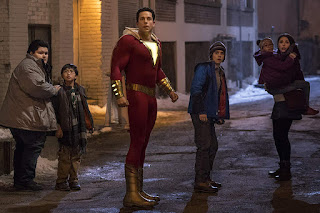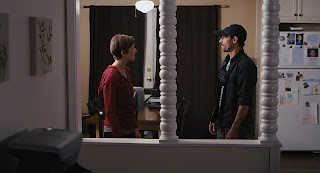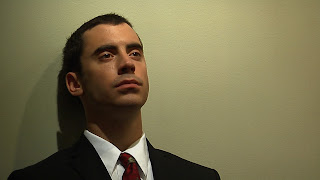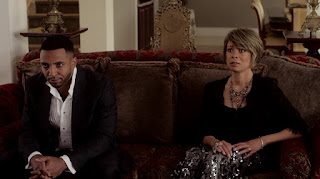Movie Review - Shazam!
This is the seventh film in the DC Extended Universe or DCEU. It's also the seventh in the Zack Snyder universe or Snyder-verse. This is in reference to the fact that Snyder directed the first installment in the DCEU, that of Man of Steel (2013), the dark and gritty reboot of Superman, the most popular character in the DC Comics pantheon. Up until recently, Snyder has also overseen the DCEU films and despite his lack of involvement, ostensibly, over the past two years, his aesthetic still feels very much a part of this film. It's weird that Snyder's involvement is the least here probably because the protagonist in this one in terms of abilities and status feels the most like Superman. The titular hero even looks like Superman, certainly with regard to his costume. Actually, his costume is more of a cross between that of Superman and The Flash.
Directed by David F. Sandberg (Annabelle: Creation and Lights Out) and written by Henry Gayden (Earth to Echo), this movie references Superman enough in dialogue and in other ways. Another film this movie references is Big (1988), the Tom Hanks flick in which a 13-year-old boy is magically transformed into a 30-year-old man. Maybe that Hanks' film borrowed from this comic book idea, which originated in 1939, but this is the first live-action version to incorporate a child becoming a man instantaneously. There was a live-action version made in 1941 but the child in question was actually an adult played by an actor in his twenties.
Asher Angel was only 14 or 15 when he was cast to play Billy Batson, the boy who is magically transformed into a man. Instead of Tom Hanks, the man is played by Zachary Levi (Heroes: Reborn and Chuck). Instead of becoming a business executive, he becomes a big, buff super-hero. Instead of being trapped inside that adult body, the boy here can become a teenager again at will and on command.
This trick takes a bit of the drama away from the internal struggle that would come from having your whole body and thus whole life taken away. In other words, the comparisons to Big are lost or undermined. Billy can transform back-and-forth when he says the word "Shazam," which is an acronym for the names of six mythical heroes: Solomon, Hercules, Atlas, Zeus, Achilles and Mercury. Because Billy can switch back-and-forth, the super-hero persona is like a costume or suit that he can put on or take off with ease. In that, it's not unlike when Clark Kent becomes Superman.
The closer comparison though would be to Peter Parker and Spider-Man, but the version as portrayed in the recent Spider-Man: Homecoming (2017). Peter Parker is a teenager in that film and he takes on this adult persona. His physical body changes but not to the degree that Billy's does. Peter doesn't double in size in terms of height or weight, but he does get more muscular. The majority of Peter's scenes are in school and with his best friend, Ned.
Jack Dylan Grazer (Beautiful Boy and It) co-stars as Freddy Freeman, a disabled foster child in the same grade as Billy. Grazer isn't disabled in real life, just to note, but Freddy becomes Billy's foster brother when the Vasquez couple accept Billy into their foster home in Philadelphia. Freddy also becomes Billy's best friend in the same vein as Ned to Peter/Spider-Man. Freddy is a fan of Superman, not just as a concept but as a real person, given that this film takes place in the DCEU, so here Superman is real. The reason we know all this is because Freddy is very talkative and wise-cracking.
Mark Strong (Sherlock Holmes and Kingsman: The Secret Service) also co-stars as Thaddeus Sivana, a scientist trying to steal the power of Shazam. If this were Spider-Man: Homecoming, he'd be the character played by Michael Keaton. Thaddeus is obviously the villain. This film opens with a prologue that establishes his motivation as a villain like Spider-Man: Homecoming did or even how The Incredibles (2004) did. However, Thaddeus is more comparable to Riz Ahmed's character in Venom (2018), which is a spin-off of the Spider-Man story. Ahmed's character was a scientist trying to steal the power of the protagonist in that film, and Thaddeus is just as ruthless and brutal.
When it comes to villains, Thaddeus is also reminiscent of Jafar in Disney's Aladdin (1992). Jafar wanted access to a cave in which would give him god-like power. The cave tells him that he's not worthy to enter the cave, let alone have access to that power. Instead of a talking cave, the cave here is magical but it doesn't talk. Instead, a wizard, played by Djimon Hounsou (Aquaman and Guardians of the Galaxy), who like Jafar tells Thaddeus he's not worthy.
For Jafar, it's obvious to see why he's not worthy to be given such god-like power. When Thaddeus is first brought to the cave, he's only a child. The wizard deems him unworthy rather unfairly and maybe the wizard made a mistake, but he's never read as much in the text of the film. The wizard deems him unworthy for being tempted to take power when the reason the wizard brought Thaddeus there was to tempt him with power.
Later, when Billy is brought to the cave, the wizard says he's worthy, but the wizard never explains why. A casual reference of being pure of heart is thrown out, but what does that mean? Billy is introduced in a scene in which he steals a cop car. He rejects his foster family and steals from Freddy. When he gets his power, he uses it to go to a strip club, so I don't get what Billy's pure of heart is supposed to mean.
What's revealed is that the wizard has been going through tons of people, trying to find a worthy one, and it's never clarified why any of them weren't worthy. It's never specified why Billy is and no one else before that was. Yes, he stands up against bullies in school in one scene, but in the Vasquez foster home, there are other children who are pure of heart and who would stand up to bullies too. It's a wonder why the Vasquez couple themselves either the father or the mother weren't chosen by the wizard.
In stories that involve this kind of chosen-one narrative, typically the chosen one is a young, white, heterosexual, cisgender male. For two-thirds of this movie, that trope seems like it's going to be all this movie is. Yet, by the end, the last act and penultimate sequence turns this movie into Power Rangers (2017) or a kind of Jumanji: Welcome to the Jungle (2017) where it's not just one white kid who's the chosen one but it's a group of diverse young people who become the chosen one and are given new identities and new powers.
It's similar to the ending or the final season of the TV series Buffy the Vampire Slayer. Instead of being just one person, it's revealed that a diverse group of people can all have the power to fight evil and do good. It's akin to what was happening in the final season of ABC's Lost. This film though doesn't have enough time dedicated to developing that diverse group of people. It's not to say this film needed hours of screen time, but maybe an extra ten or twenty minutes would have sufficed.
The other foster kids become important after the movie spends the minimal amount establishing them and in some cases, even that wasn't enough. Having them become heroes at the last minute wasn't emotionally satisfying because I was still wondering who they were beyond their ethnicity. They could be distinguished because one was a black girl. One was Latino. One was Asian. One was a white guy and one was a white girl, but other than that I couldn't tell you much about who they were.
There's an animated sequence at the end that has Batman and Aquaman interacting with Billy. Having those Justice League characters show up in this film's climax would have been just as good as the foster kids because at least we know Batman and Aquaman as characters.
Rated PG-13 for action, language and suggestive material.
Running Time: 2 hrs. and 12 mins.
Directed by David F. Sandberg (Annabelle: Creation and Lights Out) and written by Henry Gayden (Earth to Echo), this movie references Superman enough in dialogue and in other ways. Another film this movie references is Big (1988), the Tom Hanks flick in which a 13-year-old boy is magically transformed into a 30-year-old man. Maybe that Hanks' film borrowed from this comic book idea, which originated in 1939, but this is the first live-action version to incorporate a child becoming a man instantaneously. There was a live-action version made in 1941 but the child in question was actually an adult played by an actor in his twenties.
Asher Angel was only 14 or 15 when he was cast to play Billy Batson, the boy who is magically transformed into a man. Instead of Tom Hanks, the man is played by Zachary Levi (Heroes: Reborn and Chuck). Instead of becoming a business executive, he becomes a big, buff super-hero. Instead of being trapped inside that adult body, the boy here can become a teenager again at will and on command.
This trick takes a bit of the drama away from the internal struggle that would come from having your whole body and thus whole life taken away. In other words, the comparisons to Big are lost or undermined. Billy can transform back-and-forth when he says the word "Shazam," which is an acronym for the names of six mythical heroes: Solomon, Hercules, Atlas, Zeus, Achilles and Mercury. Because Billy can switch back-and-forth, the super-hero persona is like a costume or suit that he can put on or take off with ease. In that, it's not unlike when Clark Kent becomes Superman.
The closer comparison though would be to Peter Parker and Spider-Man, but the version as portrayed in the recent Spider-Man: Homecoming (2017). Peter Parker is a teenager in that film and he takes on this adult persona. His physical body changes but not to the degree that Billy's does. Peter doesn't double in size in terms of height or weight, but he does get more muscular. The majority of Peter's scenes are in school and with his best friend, Ned.
Jack Dylan Grazer (Beautiful Boy and It) co-stars as Freddy Freeman, a disabled foster child in the same grade as Billy. Grazer isn't disabled in real life, just to note, but Freddy becomes Billy's foster brother when the Vasquez couple accept Billy into their foster home in Philadelphia. Freddy also becomes Billy's best friend in the same vein as Ned to Peter/Spider-Man. Freddy is a fan of Superman, not just as a concept but as a real person, given that this film takes place in the DCEU, so here Superman is real. The reason we know all this is because Freddy is very talkative and wise-cracking.
Mark Strong (Sherlock Holmes and Kingsman: The Secret Service) also co-stars as Thaddeus Sivana, a scientist trying to steal the power of Shazam. If this were Spider-Man: Homecoming, he'd be the character played by Michael Keaton. Thaddeus is obviously the villain. This film opens with a prologue that establishes his motivation as a villain like Spider-Man: Homecoming did or even how The Incredibles (2004) did. However, Thaddeus is more comparable to Riz Ahmed's character in Venom (2018), which is a spin-off of the Spider-Man story. Ahmed's character was a scientist trying to steal the power of the protagonist in that film, and Thaddeus is just as ruthless and brutal.
When it comes to villains, Thaddeus is also reminiscent of Jafar in Disney's Aladdin (1992). Jafar wanted access to a cave in which would give him god-like power. The cave tells him that he's not worthy to enter the cave, let alone have access to that power. Instead of a talking cave, the cave here is magical but it doesn't talk. Instead, a wizard, played by Djimon Hounsou (Aquaman and Guardians of the Galaxy), who like Jafar tells Thaddeus he's not worthy.
For Jafar, it's obvious to see why he's not worthy to be given such god-like power. When Thaddeus is first brought to the cave, he's only a child. The wizard deems him unworthy rather unfairly and maybe the wizard made a mistake, but he's never read as much in the text of the film. The wizard deems him unworthy for being tempted to take power when the reason the wizard brought Thaddeus there was to tempt him with power.
Later, when Billy is brought to the cave, the wizard says he's worthy, but the wizard never explains why. A casual reference of being pure of heart is thrown out, but what does that mean? Billy is introduced in a scene in which he steals a cop car. He rejects his foster family and steals from Freddy. When he gets his power, he uses it to go to a strip club, so I don't get what Billy's pure of heart is supposed to mean.
What's revealed is that the wizard has been going through tons of people, trying to find a worthy one, and it's never clarified why any of them weren't worthy. It's never specified why Billy is and no one else before that was. Yes, he stands up against bullies in school in one scene, but in the Vasquez foster home, there are other children who are pure of heart and who would stand up to bullies too. It's a wonder why the Vasquez couple themselves either the father or the mother weren't chosen by the wizard.
Spoiler alert! Spoiler alert! Spoiler alert!
In stories that involve this kind of chosen-one narrative, typically the chosen one is a young, white, heterosexual, cisgender male. For two-thirds of this movie, that trope seems like it's going to be all this movie is. Yet, by the end, the last act and penultimate sequence turns this movie into Power Rangers (2017) or a kind of Jumanji: Welcome to the Jungle (2017) where it's not just one white kid who's the chosen one but it's a group of diverse young people who become the chosen one and are given new identities and new powers.
It's similar to the ending or the final season of the TV series Buffy the Vampire Slayer. Instead of being just one person, it's revealed that a diverse group of people can all have the power to fight evil and do good. It's akin to what was happening in the final season of ABC's Lost. This film though doesn't have enough time dedicated to developing that diverse group of people. It's not to say this film needed hours of screen time, but maybe an extra ten or twenty minutes would have sufficed.
The other foster kids become important after the movie spends the minimal amount establishing them and in some cases, even that wasn't enough. Having them become heroes at the last minute wasn't emotionally satisfying because I was still wondering who they were beyond their ethnicity. They could be distinguished because one was a black girl. One was Latino. One was Asian. One was a white guy and one was a white girl, but other than that I couldn't tell you much about who they were.
There's an animated sequence at the end that has Batman and Aquaman interacting with Billy. Having those Justice League characters show up in this film's climax would have been just as good as the foster kids because at least we know Batman and Aquaman as characters.
Rated PG-13 for action, language and suggestive material.
Running Time: 2 hrs. and 12 mins.

















Comments
Post a Comment